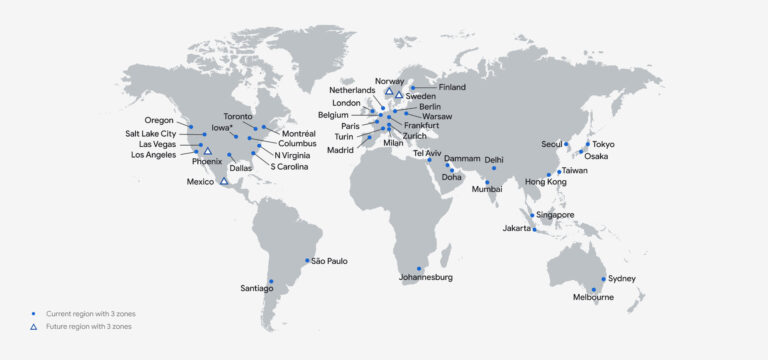As of June 2024 GCP has more than 40 regions available and 121 Zones worldwide. GCP has announced multiple new datacenters in the years to come which we will explore at the end of the article. The infrastructure coverage that offer Google Cloud is almost as large as AWS and Azure.
Table of Google Cloud Regions and zones:
| City | Regions | Zones |
|---|---|---|
| Johannesburg, South Africa | Africa | southafrica-north-a, southafrica-north-b, southafrica-north-c |
| Changhua County, Taiwan | APAC | asia-east1-a, asia-east1-b, asia-east1-c |
| Hong Kong | APAC | asia-east2-a, asia-east2-b, asia-east2-c |
| Jakarta, Indonesia | APAC | asia-southeast2-a, asia-southeast2-b, asia-southeast2-c |
| Jurong West, Singapore | APAC | asia-southeast1-a, asia-southeast1-b, asia-southeast1-c |
| Mumbai, India | APAC | asia-south1-a, asia-south1-b, asia-south1-c |
| Osaka, Japan | APAC | asia-northeast2-a, asia-northeast2-b, asia-northeast2-c |
| Seoul, South Korea | APAC | asia-northeast3-a, asia-northeast3-b, asia-northeast3-c |
| Sydney, Australia | APAC | australia-southeast1-a, australia-southeast1-b, australia-southeast1-c |
| Tokyo, Japan | APAC | asia-northeast1-a, asia-northeast1-b, asia-northeast1-c |
| Frankfurt, Germany | Europe | europe-west3-a, europe-west3-b, europe-west3-c |
| Hamina, Finland | Europe | europe-north1-a, europe-north1-b, europe-north1-c |
| London, England, UK | Europe | europe-west2-a, europe-west2-b, europe-west2-c |
| Madrid, Spain | Europe | europe-southwest1-a, europe-southwest1-b, europe-southwest1-c |
| Milan, Italy | Europe | europe-west8-a, europe-west8-b, europe-west8-c |
| Paris, France | Europe | europe-west9-a, europe-west9-b, europe-west9-c |
| St. Ghislain, Belgium | Europe | europe-west1-a, europe-west1-b, europe-west1-c |
| Warsaw, Poland | Europe | europe-central2-a, europe-central2-b, europe-central2-c |
| Zurich, Switzerland | Europe | europe-west6-a, europe-west6-b, europe-west6-c |
| Doha, Qatar | Middle East | me-central1-a, me-central1-b, me-central1-c |
| Tel Aviv, Israel | Middle East | me-west1-a, me-west1-b, me-west1-c |
| Montreal, Quebec, Canada | North America | northamerica-northeast1-a, northamerica-northeast1-b, northamerica-northeast1-c |
| Toronto, Ontario, Canada | North America | northamerica-northeast2-a, northamerica-northeast2-b, northamerica-northeast2-c |
| Council Bluffs, Iowa, USA | North America | us-central1-a, us-central1-b, us-central1-c, us-central1-f |
| Las Vegas, Nevada, USA | North America | us-west4-a, us-west4-b, us-west4-c |
| Los Angeles, California, USA | North America | us-west2-a, us-west2-b, us-west2-c |
| Moncks Corner, South Carolina, USA | North America | us-east1-b, us-east1-c, us-east1-d |
| New York, New York, USA | North America | us-east4-a, us-east4-b, us-east4-c |
| Salt Lake City, Utah, USA | North America | us-west3-a, us-west3-b, us-west3-c |
| San Francisco, California, USA | North America | us-west1-a, us-west1-b, us-west1-c |
| Ashburn, Virginia, USA | North America | us-east4-a, us-east4-b, us-east4-c |
| Dallas, Texas, USA | North America | us-south1-a, us-south1-b, us-south1-c |
| Seattle, Washington, USA | North America | us-west1-a, us-west1-b, us-west1-c |
| Santiago, Chile | South America | southamerica-west1-a, southamerica-west1-b, southamerica-west1-c |
| São Paulo, Brazil | South America | southamerica-east1-a, southamerica-east1-b, southamerica-east1-c |
| Queretaro, Mexico | North America | northamerica-northeast1-a, northamerica-northeast1-b, northamerica-northeast1-c |
| Columbus, Ohio, USA | North America | us-east5-a, us-east5-b, us-east5-c |
| Warsaw, Poland | Europe | europe-central2-a, europe-central2-b, europe-central2-c |
| Santiago, Chile | South America | southamerica-west1-a, southamerica-west1-b, southamerica-west1-c |
How GCP Regions and Zones work?

Google Cloud Platform (GCP) organizes its infrastructure into regions and zones to ensure high availability, redundancy, and low-latency performance for users worldwide.
Regions are specific geographical locations where GCP resources are deployed. Each region consists of multiple zones. A zone is an isolated data center within a region. The separation into regions and zones allows GCP to provide high availability and fault tolerance. If one zone experiences an outage, other zones within the same region can continue to operate, minimizing disruptions to services.
Each region is identified by a specific name, such as “us-central1” for the central United States or “asia-east1” for East Asia. These regions are strategically distributed across the globe, enabling users to deploy resources close to their customers, reducing latency and improving performance.
Zones, on the other hand, are designated with additional identifiers, like “us-central1-a” or “asia-east1-b”. Each zone is a collection of GCP resources isolated from others within the same region. This isolation means that zones have independent power, cooling, and networking, reducing the risk of simultaneous failures.
GCP users can deploy their resources across multiple zones within a region to ensure redundancy. For example, by setting up a cloud storage system in two different zones within the same region, users can achieve high availability. If one zone goes down, the other can take over, ensuring continuous service.
Furthermore, GCP offers various tools and services, such as multi-region storage and global load balancing, to help users seamlessly manage their applications across multiple regions and zones. This architecture not only boosts performance but also provides a robust disaster recovery framework, making GCP a reliable choice for businesses with critical uptime requirements.
Google cloud Regions and Zones expansion
In recent years, GCP has significantly ramped up its global presence. For example, in 2023, GCP opened new regions in Berlin (Germany), Doha (Qatar), Dammam (Saudi Arabia), Johannesburg (South Africa) each comprising multiple zones. This expansion allows businesses in these regions to run applications closer to their customers, reducing latency and improving performance.
Google has invested billions of dollars in its cloud infrastructure. For instance, the company committed to investing $10 billion in 2020 alone to expand data centers and renewable energy projects. Each new region represents a substantial financial commitment, often ranging from hundreds of millions to over a billion dollars, depending on the complexity and scale of the data centers.
The Jakarta region, for example, involved a significant investment to build state-of-the-art facilities that comply with local regulations and meet the high standards of performance and security expected by GCP customers. Additionally, investments in undersea cables, such as the Dunant and Curie cables, further enhance connectivity between regions, ensuring faster and more reliable global communications.
Google Cloud announced that they will further expand into the following regions: Mexico, Malaysia, Thailand, New Zealand, Greece, Norway, Austria, and Sweden.
Wrap Up: Optimizing Your GCP Footprint
Understanding Google Cloud Platform (GCP) regions and zones is crucial for optimizing your cloud environment. Considerations like latency, data residency regulations, and cost can all influence your choice of location. For example, deploying resources closer to your users can minimize latency, while some regions might offer more competitive pricing.
While GCP provides default regions, zones and virtual private clouds (VPCs) with each account, managing numerous resources across diverse locations can quickly become complex. This can lead to “shadow IT” or hidden costs associated with unused resources. Here’s where Holori steps in.
Holori acts as your GCP cartographer, automatically generating a visual representation of your entire cloud infrastructure. This includes pinpointing your resources across regions and zones, alongside valuable cost insights. By visualizing your GCP environment, Holori helps you identify underutilized resources (“zombie resources”) and optimize your overall cloud spend. Leverage Holori’s power to gain complete control over your GCP footprint and ensure cost-efficiency and optimal performance.
Try it out now for free: https://app.holori.com/





